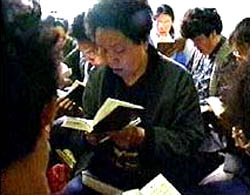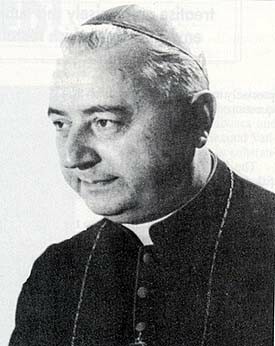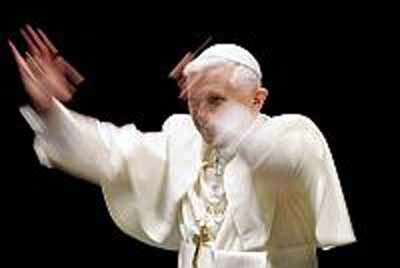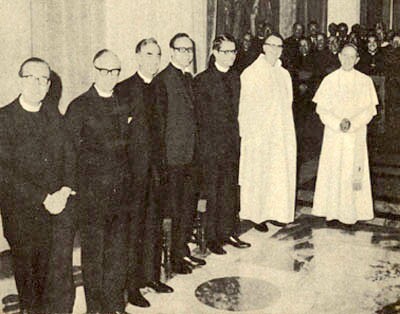 |
NEWS: July 18, 2007
Bird’s Eye View of the News
Atila Sinke Guimarães
THE MOTU PROPRIO, AFTER THE EMOTIONS - Significant segments of the conservative and traditionalist movements received Pope Benedict XVI’s motu proprio Summorum Pontificum released last July 7 with a strong emotional reaction. Such emotion, which now seems to be subsiding to a more reasonable level, can be explained.
Indeed, the expectations of so many who shed tears of joy when Card. Ratzinger was elected Pope desperately needed some pretext to expand.
Until now, Benedict had seemed to forget that those people who considered him a conservative were expecting him to say something they could applaud. They had been successively discouraged by a continuous chain of events. The following were Benedict’s landmark initiatives favoring Progressivism:
- A democratic way of exerting his power as Pope;
- His choice of Card. Levada, to lead the Congregation of the Doctrine of the Faith;
- His support of Card. Law, maintaining him in several important situations at the Vatican;
- His insistent attempts to unite with the Greek Schismatics no matter what offenses they make and doctrinal errors they sustain;
- His constant praise of the Augsburg accord with the Protestants (drafted by Card. Ratzinger), in which the doctrine of Trent on justification was given away;
- His visit to the synagogue in Germany, and obsessive support of Judaism on many occasions;
- His presence at World Youth Day, “blessing” its many liberal procedures;
- His four-hour visit with Fr. Hans Kung at the Vatican;
- His abolition of the papal title Patriarch of the West;
- A document permitting homosexuals in the seminaries;
- His visit to the mosque in Constantinople;
- His Encyclical Deus caritas est, which avoids dealing with the major problems of modern morality;
- His initiative to fast-track John Paul II's canonization;
- His virtual abolition of Limbo; and so on.
Toward those naïve conservatives, Pope Ratzinger had showed himself heartless, doing very little to justify their hopes. Practically the only carrot hanging from the tip of the stick to sustain his myth of being conservative was the 2-year-postponed motu proprio.
So, when it came, and in fact allowed the Tridentine Mass to be said broadly, all those disappointed expectations experienced a sudden moment of decompression. Understandably, tears appeared in the eyes of many ladies, hurrahs spontaneously spurted from the mouths of many men. I fully understand this psychological need. Any civilized person respects the tears and sufferings of forgotten or mistreated children.
However, I cannot have the same complacence with some opportunists who are trying to manipulate this honest reaction in order to accomplish their own agenda of compromise. I cannot condone them. I will deal with them later, at another opportunity.
Given that some of those first emotions have settled down, I surmise it possible to offer a coherent analysis of the motu proprio (m.p.) and its introductory letter (i.l.).
The big picture

Underground Catholics, above, are pressured to surrender to Communism |
To be fair in one’s appraisal of the intentions of Pope Benedict XVI, the first element to take into consideration is that one should evaluate his motu proprio along with its monstrous twin sister. I am referring to the letter he released almost simultaneously delivering the ensemble of the underground Chinese Catholics to the Communist regime. The same Benedict who wrote one letter, also wrote the other within the period of just a few days.
Thus, in the West, Benedict opened the Tridentine Mass to a larger number of conservatives; in the East he delivered our heroic brothers in the Faith to the hyenas. With one hand he gave life, with the other he spread death. Conservative in the West, he could not have been more progressivist in the East. In my opinion, any appraisal of the motu proprio that skips the letter to the Chinese Catholics is incomplete. It shows only one side of Benedict’s face.
The fact that he wrote the motu proprio and the letter to the Chinese Catholics concurrently sets aside the naïve rumor that he is converting. No one who is converting delivers around 10 million of the Catholic faithful to Communism.
What was granted
Almost everyone has been talking about what will be granted to Catholics after September 14, 2007, but let me summarize the gains.
What was granted is that:
- Without people present, a priest can say a Tridentine Mass according to the 1962 Missal without the permission of anyone (m.p., art. 2);
- A particular religious institute may regularly adopt the Tridentine Mass at its own discretion (ibid, art 3);
- With people present, a priest can celebrate the Tridentine Mass if permitted by the pastor of the church (ibid, art 4 § 1).
Item 1 opens the door for the Tridentine Mass to be said in private by any priest. Even though it had never been abrogated (ibid, art 1), it was practically forbidden after the Liturgical Reform of Paul VI entered into effect. Item 1 is turned toward easing the problems of conscience of those with scruples about saying the New Mass. Benedict wants to prevent them from taking a position of resistance.
It seems to me that item 2 is principally turned toward the SSPX after its possible agreement with the Vatican. It also applies to other compromised traditionalist institutes such as the Fraternity of St. Peter, the Institute of Christ the King, the Apostolic Administration of St. John Mary Vianney, the Institute of the Good Shepherd, etc. They can say the Tridentine Mass inside their institutions. It is not so probable that Jesuits or Benedictine will be saying Tridentine Masses in their Orders.
Item 3 refers to the normal life of parishes and establishes when a priest can say the Tridentine Mass for an ensemble of people. It depends on some conditions.
The Missal of 1962

Fr. Bugnini, architect of both the New Mass and the 1962 Missal |
Regarding the 1962 Missal, it is important to note that, as far as I know, it was one of the achievements of Fr. Annibale Bugnini. Indeed, to my knowledge Bugnini had five principal accomplishments during his career:
- The 1955 reform of Holy Week services, under Pius XII;
- The 1962 reform of the Missal and Roman Breviary, under John XXIII;
- Also in 1962, the draft of Sacrosanctum Concilium, Vatican II’s document on liturgy, which was approved by the assembly with minor modifications;
- The 1970 Novus Ordo Mass of Paul VI;
- The entire Liturgical Reform of Paul VI.
It is very beautiful to say, as Benedict did, that the 1962 Missal was made by Pope John XXIII, in contrast with the Novus Ordo Mass made by Pope Paul VI. It is a pleasant ruse, but it does not reflect reality, for both were produced by the same Fr. Annibale Bugnini. In the 1962 Missal, Bugnini was already preparing the New Mass to come. In it he introduced as many modifications as he could at the time.
This is not the place, however, to delve into details on the 1962 Missal.
Doctrinal conditions
The apparently conservative motu proprio has, nevertheless, some progressivist doctrinal demands:
The first demand is for the celebrant to accept the New Mass: “Needless to say, in order to experience full communion, the priests of the communities adhering to the former usage cannot, as a matter of principle, exclude celebrating according to the new books. The total exclusion of the new rite would not in fact be consistent with the recognition of its value and holiness” (i.l., at the end - the bold is mine).
This condition has already been in place for the priests in the mentioned compromised institutes that received permission from the Ecclesia Dei Commission to celebrate the Tridentine Mass. They must not only recognize the “value and holiness” of the New Mass, but have to say at least one New Mass a year to keep their celebret.
This first demand sets aside all priests who have doctrinal objections to the Novus Ordo Mass. If anyone imagines that a priest with such objections can appear in a church and ask permission to say the Tridentine Mass, such person is roundly mistaken. It will not happen. He “cannot, as matter of principle, exclude celebrating according to new books,” affirms Benedict.

Benedict XVI waves to the conservatives, but demands they accept the New Mass and Vatican II |
The second demand is indirect. It refers to the acceptation of Vatican II. In the exposition of reasons for his motu proprio Pope Ratzinger invokes Vatican II. In his introductory letter he clearly states: “There is the fear that the document detracts from the authority of the Second Vatican Council, one of whose essential decisions – the liturgical reform – is being called into question. This fear is unfounded.”
Benedict foresees no risk that the moto proprio will cause anyone to call into question Vatican II, which necessarily means that one of the conditions for a priest to receive permission to say the Tridentine Mass is to agree with Vatican II.
He knows, as everyone does, that various institutes – the Fraternity of St. Peter, the Institute of Christ the King, the Apostolic Administration of St. John Mary Vianney, and the Institute of the Good Shepherd – have already agreed with Vatican II. So, this message is not directed to them, but rather to another association that is approaching an agreement. Regarding the latter, Benedict’s discrete reference to an “unfounded fear” is a message to the Bishops saying, “I will not allow anyone to receive such permission unless he agrees with Vatican II. You can be sure of that.”
So, if he fulfils these two conditions, any priest who has the juridical approval of the Diocese and knows his Latin and the rubrics of the 1962 Missal, can appear in any parish and ask permission to say the Tridentine Mass for a certain group of people. The pastor will assent if he is sure “that the welfare of these faithful harmonizes with the ordinary pastoral care of the parish, avoiding discord and favoring the unity of the whole Church” (m.p., art. 5 § 1). That is, this is the moment for the pastor to check if the priest has objections against the New Mass or Vatican II. If he does, or the pastor thinks that such permission could displease the Bishop and jeopardize his career, he can simply refuse permission. If this occurs, priest and faithful can go to the Bishop, and if he does not allow it, then they can appeal to the Vatican.
Up until now – I write on July 17 – several priests have already publicly denied any Tridentine Mass for their parishes. Some Prelates, such as Bishop Donald Trautman of Erie, Pennsylvania, have also refused permission. Card. Roger Mahony, through his spokesman, put out some statements that are very close to a general refusal for more Tridentine Masses.
If such cases become more general, the whole picture, apparently so favorable to conservatives, ends by being not so different from what has been permitted to this date, where the rare celebrations of the Tridentine Mass are relegated to inconvenient hours and places in order not to disturb attendance at the Novus Ordo.
Doctrinal omissions
Interesting enough, in neither the motu proprio nor his introductory letter does Benedict XVI say a word about the main doctrinal objections against the Novus Ordo Mass as favoring Protestantism, or against Vatican II and its fruits as being contrary to the previous Catholic Magisterium.

Paul VI with the Protestant theologians he invited to help write the New Mass. He wanted to be sure that nothing would displease their heresy |
Instead, the increasing number of Catholics who are turning their backs to the Novus Ordo Mass and attending the Tridentine Mass were presented as a phenomenon of nostalgia for the rite “familiar to them from childhood.” Or, they would just be attracted by “the sacrality” of the Tridentine Mass. At most, their rejection of the New Mass is presented as a reaction against some ill-advised “arbitrary deformations.”
This picture is palpably incomplete. Benedict XVI purposely omitted mentioning a whole spectrum of doctrinal objections against the Novus Ordo Missae: it has a pronounced flavor of Protestantism, which is the same as saying it has the strong savor of heresy; it does away with the sacrificial essence of the Mass; it dethrones God and enthrones the people; it lacks respect for the Divine Majesty; it is deficient with regard to the Blessed Sacrament and the formulas of the Canon, etc.
It is my understanding that a well-intentioned Pope should first and above all try to resolve the serious doctrinal objections innumerable Catholics have against the Novus Ordo Mass and Vatican II. However, Benedict XVI did not do this. He flagrantly skipped over addressing any doctrinal objection.
Strategic approach
Since serious doctrinal objections were not addressed, the whole initiative is reduced to boosting good feeling, not to reinforcing good principles. More solemn ceremonies, more silence and recollection, more beautiful music, more incense, all these are good things, but they all can be found either in the 1962 celebrations or in the already approved New Mass said in Latin.
So, the motu proprio and its introductory letter can properly be understood as an effort to silence the true traditionalists: “Shut up with your doctrinal questions.” Also, as an effort to encourage all conservative Catholics who do not care about principles to accept one of the options now proffered: the Tridentine Mass according to the 1962 Missal, the New Mass in Latin, a solemn New Mass in the vernacular, or a modern New Mass.
These two documents, followed by another short document issued by the Congregation for the Doctrine of the Faith that is surprisingly similar to Dominus Jesus – which I hope to analyze soon – constitute an enormous effort trying to stop the growing hemorrhage of Catholics from the Novus Ordo toward conservatism, and from conservatism toward traditionalism.
It is good for us to realize how much stronger and more important traditionalism has become, with the help of Our Lady. Also, it is indispensable to consider that now is not the moment to cede on the doctrinal principles to be satisfied with good feelings.


Related Topics of Interest
 New Mass in Latin New Mass in Latin
 Lifting the Ban on the Tridentine Mass Lifting the Ban on the Tridentine Mass
 Disatrous Cost of the Vatican Ostpolitik with China Disatrous Cost of the Vatican Ostpolitik with China
 Failed Ostpolitik with Communist China Failed Ostpolitik with Communist China
 The Pope at the Mosque - A Scandal The Pope at the Mosque - A Scandal
 Card. Ratzinger: Let the Idea of Limbo Drop Card. Ratzinger: Let the Idea of Limbo Drop
 The True Colors of Benedict XVI The True Colors of Benedict XVI
 The Progressivist Orientation of Pope Ratzinger The Progressivist Orientation of Pope Ratzinger
 Inadmissable Concessions, Once Again Inadmissable Concessions, Once Again

|
News | Home | Books | CDs | Search | Contact Us | Donate

©2002- Tradition in Action, Inc. All Rights Reserved
|
 |
|